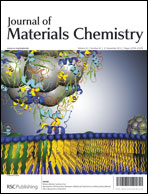Temporal stability of blue phosphorescent organic light-emitting diodes affected by thermal annealing of emitting layers†
Abstract
Emitting layers were thermally annealed at 20 to 100 °C for varying durations without causing phase transformation in the rest of the PhOLEDs. Heating EMLs above their Tgs with a free surface created pinholes filled by the underlying TAPC melt with concurrent interlayer mixing to emit satellite peaks accompanying FIrpic's phosphorescence. With a robust glassy TmPyPB layer on top of the EML, pinholes and fortuitous fluorescence could be prevented. Annealing of mCP:SiPh4:FIrpic induced crystallization in 1 h, while mCP- -PhSiPh3:FIrpic consistently resisted crystallization under all conditions. Crystallization or pinhole formation diminished EQE and driving voltage at the same time. Without incurring pinhole formation in the absence of a free surface presented by the EML, annealing of mCP:SiPh4:FIrpic at 60 °C for 1 h led to about 50% loss in EQE. In contrast, the pristine device's EQE persisted with mCP-
-PhSiPh3:FIrpic consistently resisted crystallization under all conditions. Crystallization or pinhole formation diminished EQE and driving voltage at the same time. Without incurring pinhole formation in the absence of a free surface presented by the EML, annealing of mCP:SiPh4:FIrpic at 60 °C for 1 h led to about 50% loss in EQE. In contrast, the pristine device's EQE persisted with mCP- -PhSiPh3:FIrpic annealed at 60 °C for up to 24 h, beyond which other sources of device failure took over. The concept of bipolar hybrids holds promise for mitigating morphological instability as part of the challenge to the PhOLED device lifetime.
-PhSiPh3:FIrpic annealed at 60 °C for up to 24 h, beyond which other sources of device failure took over. The concept of bipolar hybrids holds promise for mitigating morphological instability as part of the challenge to the PhOLED device lifetime.


 Please wait while we load your content...
Please wait while we load your content...